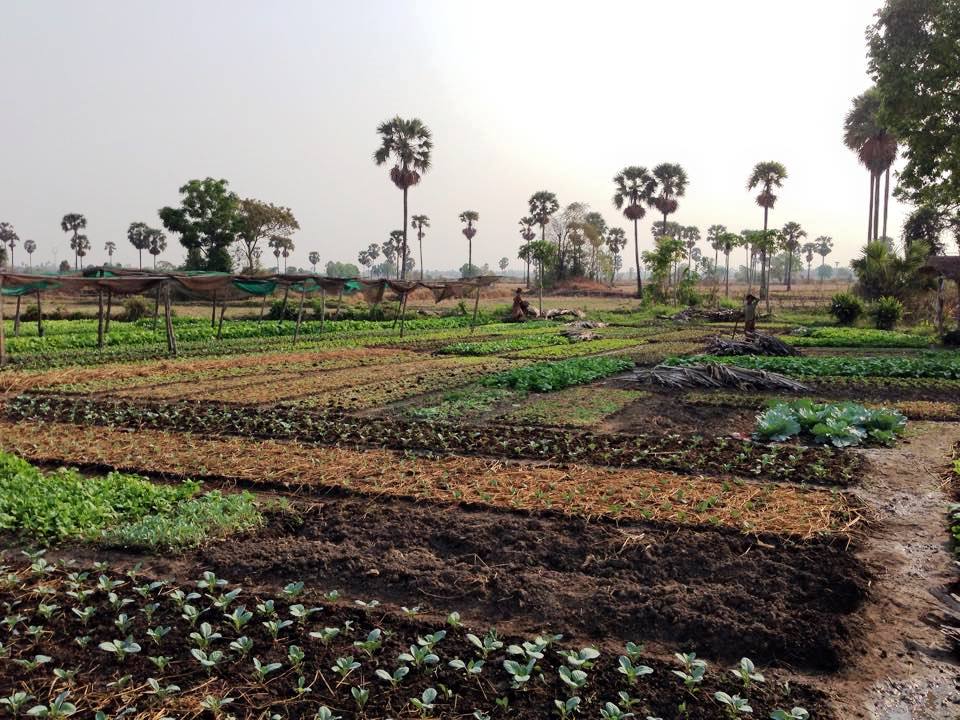English-Français

Photo by CEDAC Cambodia
×![]()
Climate funds have become a very vital source for developing countries to utilize and support their projects to address the various impacts of climate change. In recent years, amount of climate funds has been significantly increased with the new establishment of climate fund providers, particularly the Green Climate Fund. Their importance in international discussions about how to deal with climate change was cemented with the central role that such funds took in the 2015 Paris Climate Agreement. However, U.S. President Donald Trump’s decision to withdraw the US from the 2015 Paris Agreement has caused concern worldwide that such funds will face a funding shortfall.
Developing countries like Cambodia can’t afford to miss the great opportunity that climate funds present. Even as Cambodia’s economic development continues to grow, its vulnerability to the effects of climate change has become more pronounced. With over 50 percent of the country working as farmers in poor, rural settings, the threat to their livelihood from hotter and more extreme weather is high. The threat of physical and financial damage is very real.
According to a 2014 report by French NGO Geres , it is estimated that without a comprehensive and timely responsive solution to thwart climate change impacts, by 2050 Cambodia’s gross domestic product will be reduced by 3.5% annually.
The Royal Government of Cambodia has already taken some significant steps to formulate national strategic plans and policies responding to climate change — notably the creation of the ‘Climate Change Strategic Plan 2014-2023.’ Additionally, the government has integrated climate change into the budgeting and planning process and to establish the National Council for Sustainable Development (NCSD) in 2015 to oversee climate change, biodiversity, green economy and others relevant things. However, efforts to address climate issues still face obstacles including massive deforestation, construction of new dams and sand dredging—all of which heavily affect country’s environment.
With regards to climate finance, according to a senior official at the NCSD Cambodia has already mobilized domestic and international funds, which include indirectly accessing through multilateral agencies, such as the Asian Development Bank (ADB), the UNDP and other UN agencies, and individual countries under bilateral agreements, and it also has steadily increased public expenditure for climate change action.
“In real terms, Cambodia’s climate change relevant expenditure constituted 4% of public expenditure in 2015, up from 3.3% in 2009. In absolute terms, climate change expenditure has steadily increased in Cambodia over the reporting period from KHR 447 billion ($109 million) in 2010 to KHR 859 billion ($210 million) in 2015,’’ Said NCSD Secretary-General Tin Ponlok.
According to a UNDP report, up to 75% of climate related projects are funded by development partners while 25% of expenditure is funded by domestic resources.
Mr. Ponlok acknowledged that the main sources of climate finances are from major donors such as Japan, China and the ADB. In 2015, the top three sources were China (51%), ADB (25.1%), and Japan (7%).
1. Most funds go to Climate Adaptation Projects
The Cambodian government still prioritizes climate adaption projects for agriculture, infrastructure, forestry, human health, and coastal zones, which have been identified as the most vulnerable sectors to the impacts of climate change. Consequently, Cambodia continues to allocate more funds to climate adaptation projects.
The government’s support for climate adaptation policy has played an important role in helping people especially farmers across the country cope with the impacts of climate change and ensuring food security in the future. Climate adaptation effectively helps reducing vulnerabilities and strengthening people’s resilience to climate change. In 2006, the government introduced its strategy called National Adaptation Programme of Action (NAPA) to reduce climate change effects and make Cambodia’s food security less vulnerable to the climate change impacts. Rice and many other crops, specifically corn, peanuts, and cassava are the most important products contributing to Cambodia’s food security and economic growth.
According to Mr. Ponlok, the government allocated up to 76% of total climate change expenditure to the infrastructure sector in 2015.
“The irrigation sector continues to represent over one-third of climate change expenditure of the concerned ministries in Cambodia in 2015 while road and urban infrastructure expenditure and rural infrastructures (small irrigation, water and sanitation and rural roads) have continued to grow, representing respectively 27% and 9% of total climate change expenditure in 2015,” he noted.
However, while funds allocated to infrastructure have been significantly increased, the trend for expenditure in agriculture, forestry and fisheries remains “unclear, with a 28% drop in 2015 following increases in 2013 and 2014.”
2. Cambodia has more room to improve to seize more finance opportunities
To guarantee the success of adaptation projects, more funds are needed, but surely there is a lot of rooms to improve in order for Cambodia to get access to more climate finance opportunities. It is inevitable that Cambodia needs to demonstrate that it is capable of managing and utilizing funds more effectively and efficiently, as well as being able to formulate effective policy in response to climate changes. It also needs more support from donor countries and international organizations to ensure transparency and effectiveness using the funds given.
Mr. Ponlok views that there are areas that the government needs to focus on in order to seize more opportunities, despite the fact that it has been quite successful in mobilizing climate funds. He suggests the first thing the government has to do is to keep up its efforts to develop capacity building and pursue institutional reform, adding that it has to “prioritize resources and implement policies between the long-term and short-term needs.”
“In addition, national coordination mechanism has to be improved, especially functionality of the cross-sectoral coordination, and the government also needs to enhance effectiveness and efficiency of finance by integrating the climate finance in the national system.”
Developing countries like Cambodia can’t afford to miss the great opportunity that climate funds present. Even as Cambodia’s economic development continues to grow, its vulnerability to the effects of climate change has become more pronounced. With over 50 percent of the country working as farmers in poor, rural settings, the threat to their livelihood from hotter and more extreme weather is high. The threat of physical and financial damage is very real.
According to a 2014 report by French NGO Geres , it is estimated that without a comprehensive and timely responsive solution to thwart climate change impacts, by 2050 Cambodia’s gross domestic product will be reduced by 3.5% annually.
The Royal Government of Cambodia has already taken some significant steps to formulate national strategic plans and policies responding to climate change — notably the creation of the ‘Climate Change Strategic Plan 2014-2023.’ Additionally, the government has integrated climate change into the budgeting and planning process and to establish the National Council for Sustainable Development (NCSD) in 2015 to oversee climate change, biodiversity, green economy and others relevant things. However, efforts to address climate issues still face obstacles including massive deforestation, construction of new dams and sand dredging—all of which heavily affect country’s environment.
With regards to climate finance, according to a senior official at the NCSD Cambodia has already mobilized domestic and international funds, which include indirectly accessing through multilateral agencies, such as the Asian Development Bank (ADB), the UNDP and other UN agencies, and individual countries under bilateral agreements, and it also has steadily increased public expenditure for climate change action.
“In real terms, Cambodia’s climate change relevant expenditure constituted 4% of public expenditure in 2015, up from 3.3% in 2009. In absolute terms, climate change expenditure has steadily increased in Cambodia over the reporting period from KHR 447 billion ($109 million) in 2010 to KHR 859 billion ($210 million) in 2015,’’ Said NCSD Secretary-General Tin Ponlok.
According to a UNDP report, up to 75% of climate related projects are funded by development partners while 25% of expenditure is funded by domestic resources.
Mr. Ponlok acknowledged that the main sources of climate finances are from major donors such as Japan, China and the ADB. In 2015, the top three sources were China (51%), ADB (25.1%), and Japan (7%).
1. Most funds go to Climate Adaptation Projects
The Cambodian government still prioritizes climate adaption projects for agriculture, infrastructure, forestry, human health, and coastal zones, which have been identified as the most vulnerable sectors to the impacts of climate change. Consequently, Cambodia continues to allocate more funds to climate adaptation projects.
The government’s support for climate adaptation policy has played an important role in helping people especially farmers across the country cope with the impacts of climate change and ensuring food security in the future. Climate adaptation effectively helps reducing vulnerabilities and strengthening people’s resilience to climate change. In 2006, the government introduced its strategy called National Adaptation Programme of Action (NAPA) to reduce climate change effects and make Cambodia’s food security less vulnerable to the climate change impacts. Rice and many other crops, specifically corn, peanuts, and cassava are the most important products contributing to Cambodia’s food security and economic growth.
According to Mr. Ponlok, the government allocated up to 76% of total climate change expenditure to the infrastructure sector in 2015.
“The irrigation sector continues to represent over one-third of climate change expenditure of the concerned ministries in Cambodia in 2015 while road and urban infrastructure expenditure and rural infrastructures (small irrigation, water and sanitation and rural roads) have continued to grow, representing respectively 27% and 9% of total climate change expenditure in 2015,” he noted.
However, while funds allocated to infrastructure have been significantly increased, the trend for expenditure in agriculture, forestry and fisheries remains “unclear, with a 28% drop in 2015 following increases in 2013 and 2014.”
2. Cambodia has more room to improve to seize more finance opportunities
To guarantee the success of adaptation projects, more funds are needed, but surely there is a lot of rooms to improve in order for Cambodia to get access to more climate finance opportunities. It is inevitable that Cambodia needs to demonstrate that it is capable of managing and utilizing funds more effectively and efficiently, as well as being able to formulate effective policy in response to climate changes. It also needs more support from donor countries and international organizations to ensure transparency and effectiveness using the funds given.
Mr. Ponlok views that there are areas that the government needs to focus on in order to seize more opportunities, despite the fact that it has been quite successful in mobilizing climate funds. He suggests the first thing the government has to do is to keep up its efforts to develop capacity building and pursue institutional reform, adding that it has to “prioritize resources and implement policies between the long-term and short-term needs.”
“In addition, national coordination mechanism has to be improved, especially functionality of the cross-sectoral coordination, and the government also needs to enhance effectiveness and efficiency of finance by integrating the climate finance in the national system.”
© រក្សាសិទ្ធិដោយ thmeythmey.com






















